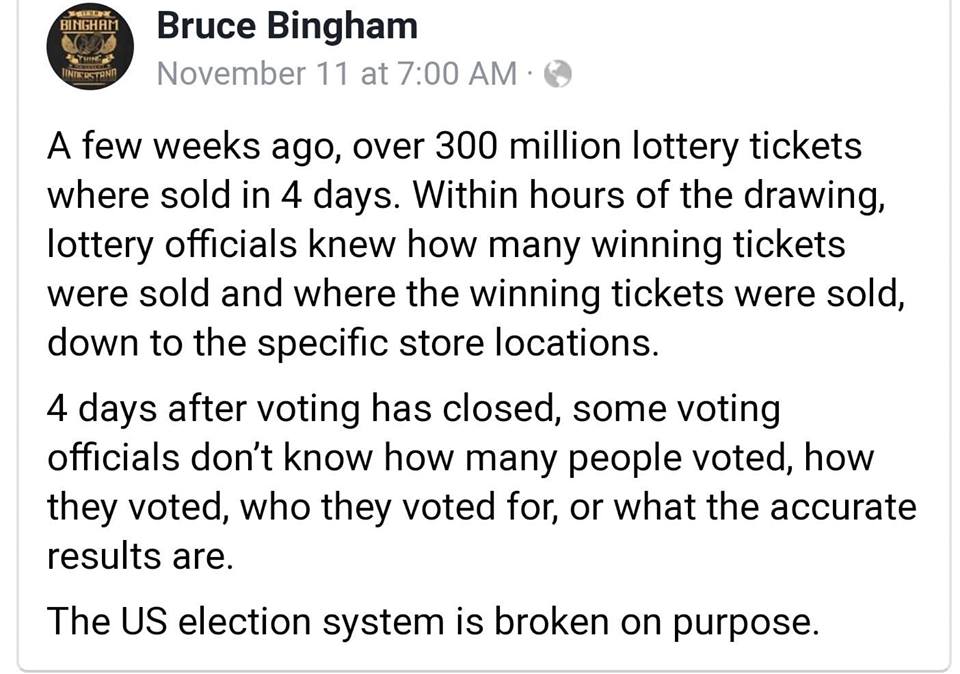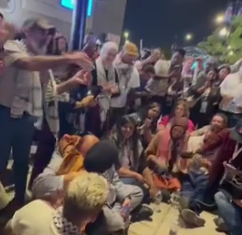This meme’s been bugging me a lot, on a couple different levels.

There’s a technical annoyance, which I’ll get to later, but there’s also this lack of history.
The election system is broken on purpose to disenfranchise some people more than others, and it’s always been a fight to get voting rights for Black people and other minorities, for women, and for poor people. Over time, it’s been improve through legislation and SCOTUS decisions.
This guy is focusing on voting machines.
Sure, there are problems with voting machines, and in some states, they went the wrong way and implemented touch screen voting rather than paper ballots, but there’s also larger issues of history, and issues of how votes are processed.
Fixating on technology is too narrow.
Now that I’ve said that, in boldface, I’m going to focus on technology.
Lotto machines and voting machines are equipment designed to implement two completely different design goals. Lotto is not an election. This should be obvious.
The fact that the lotto machine and ballot scanning machine look similar, and take a similar paper form as input, doesn’t mean the underlying goals which directed their development are the same.
Each machine fits into a different part of a process. You have one process for voting, and a completely different process for lotto.
Each process is constrained by different goals. The goals of voting differ from the goals of lotto.
Goals
The goals of voting are:
- Allow everyone who can vote, to vote.
- Do not allow any voter to vote twice.
- Do not allow ineligible people to vote.
- Ballots are secret, and a specific ballot cannot be tied back to a specific person.
The goals of lotto are:
- Do not allow counterfeit lotto tickets.
- Maintain a huge network of lotto ticket vendors, to maximize sales.
- Do not allow the vendors to generate counterfeit tickets – all tickets must be purchased, and all purchased tickets must be redeemable for a prize if they win.
Process
These two divergent goals have led to two different processes.
Voting:
- Multiple Methods: vote by mail, vote at polls, vote provisionally within a county or outside of a county, early voting locations.
- Centralized counting: all ballots taken to the Registrar, where they have counting machines, and all ballots go through these machines.
- Decentralized testing of ballots: the machines at the polls are just to confirm that the ballot can be read – it’s a error checking system, not a counting system.
- Anti-Counterfeit: the registrar has signatures and personal info to verify the likelihood that a voter is legitimate. The pollworkers collect signatures and addresses before handing out a ballot (this is a fairly lightweight anti-counterfeit, but evidently, it’s good enough).
- Secret: your ballot is “secret” and cannot be traced to you, even though the votes are “public”.
- Fault-Tolerant: if the power goes out, you have to keep allowing people to vote on their paper ballots. The people and their ballots are central to the election.
Lotto:
- Multiple Methods: manned sales machines (at liquor stores), automated kiosks (at grocery stores). Around 19,000 machines in California.
- Decentralized Sales, Centralized Tabulation: thousands of machines communicate with the central lotto service to report sales.
- Anti-Counterfeit: machines generate a receipt with numbers on it that are the anti-counterfeit feature. Each ticket is unique, and the bearer gets the prize, if any.
- Fault-Tolerant: if the power goes out, the customer goes to another location to buy a ticket. There’s no large-scale lotto without the machine to print the receipts.
In California, the machine counts of ballots cast at polls in the last election were basically concluded in one day.
Yet, California will be one of the last states to get a final count of votes.
The speed of processing votes is slower than processing lotto tickets, because voting include provisional ballots and mail-in ballots.
These ballots are in sealed envelopes, with contact information and signatures. This information is compared against the voter registration rolls before the envelope is opened. This process is manual, and slow.
I don’t know the exact process, but, it’s based on making a human decision. (It’s probably biased. However, what are the possible alternatives? Requiring the voter to produce a voter ID? That only narrows the opportunity to vote.)
Once the envelope is opened, the ballot is processed through the voting machine, which is nearly instantaneous.
Some states will only process the provisional votes if there’s an election that can be flipped in the other direction by the provisional ballots. So if all the contests are won by large margins, and there are few provisional ballots, they don’t even bother to open the envelopes.
California does the complete opposite. We have a lot of provisional and vote-by-mail ballots, and regardless of the margins of victory, all the eligible ballots are counted.
This increased count improves the odds that errors in the election won’t have an effect on the outcome. The more voters are involved, the mistakes, glitches, and fraud, in voting get minimized.
So, speed is not an indicator of accuracy or a good election.
Consider what’s Happening in Orange County
Election night concluded with 2 of 6 OC Congressional districts being represented by Republicans. That’s how it’s been for decades.
As the count has proceeded, however, the 4 districts flipped to Democratic victors, and all 6 of the districts went Democratic.
That’s happening because Democrats generally vote later than Republicans. Many of their vote by mail ballots got counted after election night.
They are Two Different Systems
It should be clear by now that voting and lotto are two different systems and cannot be compared, but I’ll go one step further.
Consider what the lotto can tell you on lotto night:
- There was a winning ticket.
- It was sold at a specific store. The store is paid a prize for selling the winning lotto ticket. This is supposed to keep them honest.
- It cannot tell you who won. The prize could even go unclaimed, though it rarely ever does. That’s because people keep their receipts. It may take a few days, but a winner shows up.
Consider what the election can tell you after the count is concluded:
- You know who won each contest.
- You can find out if your ballot was cast. So your participation in the election is “public” and verifiable.
- Nobody else knows how you voted. It’s secret. The closest they get is your precinct number. This is an essential feature, to prevent vote selling.
Does voting have problems? Yes. There’s a crisis in confidence. People don’t believe the system is functional. They probably don’t know how to check if their ballot was cast.
The government will need to move toward making it easier to know if your ballot was counted. They may even want to create a super-transparent system where you could track when your ballot was counted.
However, this will not mean we’re going to get the final results any sooner. If anything, the counting could get even slower as more people use mail-in ballots.
If you’re interested in voting issues, Tim Gooch, on a thread in Facebook, shared this link to a report about voting issues.
Securing the Vote Protecting American Democracy
If you’re interested in the history of lotto, check out this article in Wikipedia. It’s food for thought, because it describes a system that’s primitive and human-scale, and resembles voting.
Check out this article from Cengage about state lotteries.


Leave a Reply